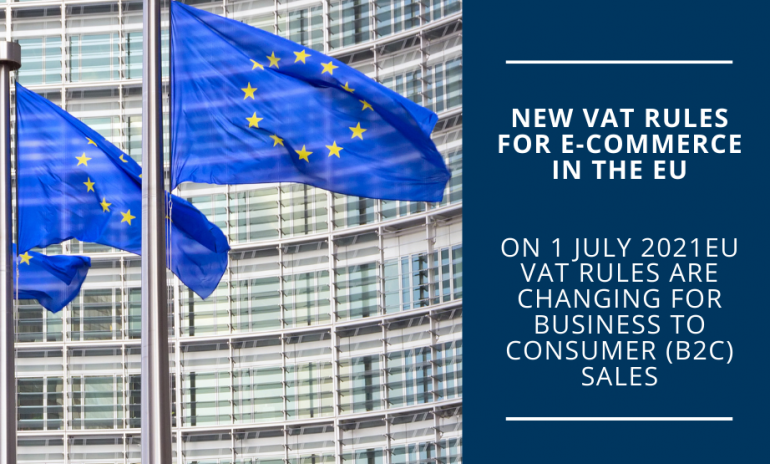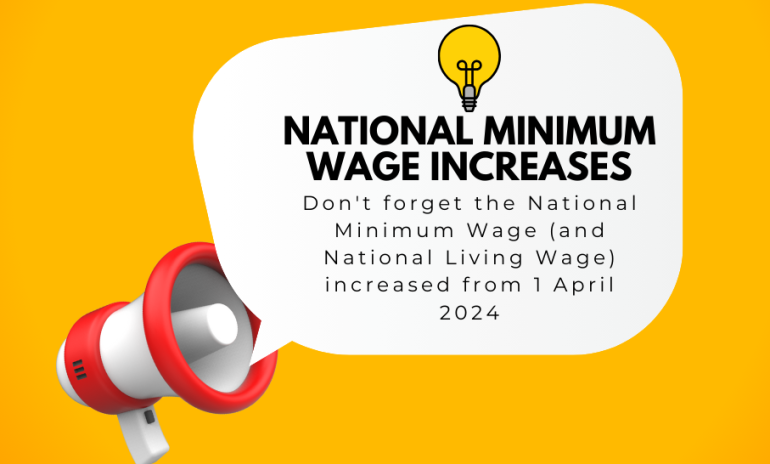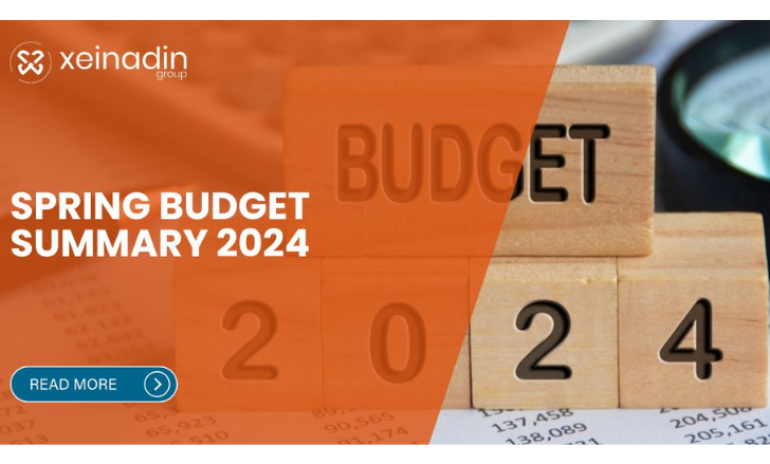New VAT rules for e-commerce in the EU
Date: 28/06/21

On 1 July 2021, the EU will roll out three reforms under the ‘VAT E-commerce Package’.
1. Launching the ‘One Stop Shop’ (OSS) EU VAT return;
3. Making online marketplaces the deemed supplier for VAT.
These reforms were delayed from 1 January this year and significantly change the requirements on UK businesses selling goods and services to final consumers in the EU.
It is key to point out that these reforms are strictly for online sales to final consumers in the EU i.e. Business to Consumer (B2C). If your business makes sales to other businesses (B2B) then there are no changes and you will continue to zero rate your sale and retain the necessary evidence of exportation.
The new measures aim to create a level playing field for all businesses – EU or non-EU, online or traditional – to reduce the opportunity for fraud and ensure VAT is paid in the member state of consumption (often referred to as ‘Destination VAT’). The new schemes are intended to help with business administration and consumer satisfaction.
1. Launching the One Stop Shop (OSS) EU VAT return
What is the OSS?
There are two versions of OSS:
- Union OSS – it can be used by:
- EU businesses making intra-EU supplies of goods and services from a fixed establishment within the EU; or
- UK businesses who hold goods at a fixed establishment within the EU supplying these goods from this fixed establishment to consumers in the EU.
- Non-Union OSS - covers supplies of services to EU customers by businesses with no establishment within the EU.
So, for UK businesses this means Union OSS can be used if supplying goods and services to EU member states when stocks of goods are held within an EU member state OR Non-Union OSS if supplying services to EU member states. If you supply goods directly from the UK to consumers within the EU then you should read section 2.
The launching of the One Stop Shop (OSS) EU VAT return means that sellers supplying services from their home country to final consumers (i.e. B2C) across the EU can opt to use Non-Union OSS to report all their pan-EU sales on a single EU VAT return.
The OSS is an extension of the 2015 Mini One-Stop-Shop (‘MOSS’), which successfully trialled a single EU return for B2C sales of digital, telecoms and broadcast services (streaming media, e-books, apps etc.).
Removing ‘Distance Selling Thresholds’
As of 1 July 2021, the EU will remove the ‘Distance Selling Thresholds’ currently in existence, which creates a powerful incentive to use OSS. Currently, the thresholds allow non-EU countries to trade across Europe without registering for VAT in those countries, provided they are below the set threshold of sales for each country. Under the current rules once the seller has surpassed the relevant country distance selling threshold they must be VAT registered in each country the threshold is exceeded in. However, the introduction of OSS will remove the need to register for VAT in each country and instead allow businesses to report VAT from all EU member states on a single EU VAT return.
What to consider before opting to use OSS?
The OSS is not a mandatory scheme.
Sales to the EU are subject to destination VAT regardless of whether you choose to use OSS or not.
The alternative to OSS would be businesses choosing to be registered for VAT in each EU country to which sales are made to. This may be relevant for any businesses that recover any VAT incurred on their related costs and expenses as OSS doesn’t allow for any recovery of VAT incurred. The OSS is only for declaring and paying the VAT due on eligible supplies. Therefore, businesses that do opt to use OSS and also wish to recover the VAT they have incurred, will have to make a claim under either the EU VAT refund system or the 13th Directive process as appropriate.
Once a business opts to use a scheme they will be required to use it for all eligible supplies and for a minimum period of two years.
What do you need to do to use OSS?
After the UK left the EU, sellers from the UK became non-EU sellers. This means to use the OSS simplified filing; the seller must first register as a ‘non-union’ taxpayer with the tax authority of any EU member state (for UK businesses it would be sensible to use Ireland due to the lack of language barriers etc.). Once registered, the seller can file quarterly OSS filings, like any EU e-commerce seller, which report all sales and relevant VAT information for every country the business has made sales to on one return, each quarter. Thus, hopefully simplifying the reporting and payment of ‘destination’ VAT.
If opting to use OSS, sellers with existing foreign VAT registrations, and selling from stock in their country of residence, may close these non-resident registrations from 1 July 2021 and use the OSS report instead.
Sellers will be required to complete the OSS in addition to their regular domestic VAT return for sales to customers within their own country of residence. For UK businesses, only domestic sales should be reported on its UK VAT return.
The seller will charge VAT at the rate of the customer’s country of residence. It is reasonable to use the delivery address of the customer to identify the country of residence.
The OSS return is intended to be standardised across all the EU member states, declaring the VAT due to each EU country by breaking down the total value of supplies, at each VAT type and rate, and by each member state.
The OSS should be filed quarterly and submitted electronically on the same date as the regular quarterly VAT return with the country in which the business has registered as a ‘non-EU’ seller.
2. Ending low-value import VAT exemption and new IOSS return
Ending low-value import VAT exemption
Up to 1 July 2021, the current EU VAT rules require no import VAT to be paid for commercial goods imported to the EU up to a value of €22. The new rules will abolish this and all commercial goods imported into the EU from a third country or third territory will be subject to VAT irrespective of their value.
What is the IOSS?
The ‘Import One-Stop-Shop’ (IOSS) scheme is for businesses that supply goods. If your business supplies services you should use the OSS scheme or if your business holds stocks of goods in an EU member state you may also use OSS.
The IOSS allows suppliers and electronic interfaces from outside the EU selling imported goods up to a value of €150 to buyers in the EU to collect, declare and pay the VAT to the tax authorities, instead of making the customer pay the VAT at the moment the goods are imported into the EU as was previously the case (for products over €22). This makes the process easier for the customer, who is only charged at the time of purchase, and therefore does not face any surprise fees when the goods are delivered. If the seller is not registered with IOSS, the consumer has to pay the VAT and usually a customs clearance fee charged by the transporter. This could mean goods are held up in customs while the VAT is calculated and paid for.
It is worth noting that IOSS covers consignments, rather than individual items. So, if a consumer orders several items totalling more than €150 and are dispatched in the same order, IOSS does not apply. Furthermore, IOSS only covers items not subject to excise duties (so not alcohol or tobacco products etc.).
What to consider before opting to use IOSS?
As with OSS, IOSS is not a mandatory scheme.
If a business opted not to use IOSS, then sales made to EU member states could continue to be made zero rated for domestic VAT purposes. The consumer would then pay the VAT upon import/delivery of the goods.
However, it is well worth considering if customer satisfaction is high on your list of priorities. By opting to use IOSS, goods may travel through customs faster because the VAT has already been calculated. It also means the end customer has full visibility of cost at the point of sale and won’t incur hidden costs further down the line when the goods go through customs.
Whether you need to opt in to use IOSS will also depend on the platform your business uses to sell its goods.
For suppliers who sell through:
- their own website, or
- an Electronic Interface E.g. a marketplace;
see the relevant sections below.
Selling through your own website
If you are a supplier selling through your own website to the EU then you can register on the IOSS portal of any EU member state (as previously mentioned, it would be sensible to use Ireland due to the lack of language barriers etc.). As the UK has left the EU, businesses based in the UK will have to appoint an EU-established intermediary to fulfil their VAT obligations under IOSS.
Unlike OSS, submissions of IOSS returns will have to be made monthly rather than quarterly.
Once registered with an EU member state, you will be issued with a unique IOSS identification number which should be listed on all packages sent to the EU. This will indicate to customs that VAT is being properly declared and help ensure speedy customs clearance.
Sellers will charge VAT at the rate of their customer’s EU country of residence at the point-of-sale on the website. Sellers can use the delivery address of the customer to determine the country's VAT rate. No VAT is due at the point of import in this case.
The IOSS is not compulsory for consignments not exceeding €150. The seller or deemed supplier marketplace may instead elect to have the import VAT collected from the final customer by the customs declarant. This is known as the Special Arrangements. This is generally the postal operator, courier firm or customs agent. They can settle the VAT collected with the tax authorities via a monthly payment.
You do not need to charge VAT on sales of goods in the following circumstances:
- You sell several goods to the same buyer, and these goods are shipped in a package amounting to more than €150. These goods will be taxed at importation in the EU Member State;
- Your distance sales of goods are facilitated by an electronic interface such as a marketplace. In this situation, the electronic interface is responsible for the VAT due. See below.
If your business sells through its own website, as well as through an Electronic Interface, then you can use IOSS to report the VAT on your website sales whilst the Electronic Interface deals with the VAT on your marketplace sales.
Selling through an Electronic Interface / Marketplace E.g. Amazon
If you are a supplier but the sale of your goods is facilitated through an electronic interface to buyers in the EU, see section 3 below.
3. Making marketplaces deemed supplier VAT
From 1 July 2021, the new rules will mean marketplaces will become the ‘deemed supplier’ when they facilitate certain cross-border Business to Consumer (B2C) transactions of their third-party sellers. The EU Council has defined ‘facilitating’ as “electronic platforms assisting sellers and consumers to come together and strike a contract for the supply of goods on a cross-border basis”.
When the marketplace becomes the ‘deemed supplier’ they also become responsible for charging and collecting VAT, thus removing the obligation from the seller using the marketplace. The VAT rate charged by the marketplace is at the rate of the consumer’s country of residence. The marketplace can then use IOSS (if registered) to pay the VAT due on the sale by the consumer. The actual seller of the goods must ensure that the IOSS VAT identification number of the ‘deemed supplier’ is listed on all packages sent to the EU.
If the actual seller sells several goods to the same buyer and these goods are shipped in a package amounting to more than €150, the marketplace doesn’t need to collect and/or report the VAT on these sales of imported goods as these goods will be taxed at importation in the EU Member State.
Bookkeeping considerations for the new VAT rules
When making sales to EU countries, the seller will charge VAT at the rate of the customer’s country of residence. It is reasonable to use the delivery address of the customer to identify the country of residence. You must determine the correct VAT rate, as well as applying reduced or nil VAT rates, according to the varying rates and goods classifications of each member state of the customer. See the following link for the VAT rates applied in the EU member states:
Due to the varying rates of VAT and the likely structure the OSS/IOSS form will take, it is imperative that your invoicing and bookkeeping system is well organised and compliant to keep track of the VAT you must pay over. For advice on how to implement systems to make your record keeping for EU VAT easier please contact Alan Taylor via alantaylor@scott-wilkinson.com.

Author: Alan Taylor FCCA
A former pupil at Ripley St Thomas C of E High School in Lancaster, Alan joined Scott & Wilkinson directly from school in 1994 and qualified as an Accountant in 2001. Alan is responsible for a variety of clients operating in...
0 Comment
Add your Comment
We have the ability to edit and/or delete posts and comments. Links should be relevant to the topics. Please note all comments are subject to review before inclusion.














Nobody has commented yet. Why not add one?